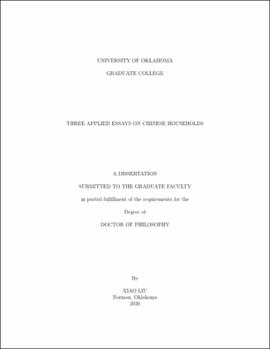| dc.contributor.advisor | Burge, Gregory | |
| dc.contributor.author | Liu, Xiao | |
| dc.date.accessioned | 2020-07-28T20:41:46Z | |
| dc.date.available | 2020-07-28T20:41:46Z | |
| dc.date.issued | 2020-07-30 | |
| dc.identifier.uri | https://hdl.handle.net/11244/325309 | |
| dc.description.abstract | My dissertation chapters focus on Chinese households decision making under specific government policies. The first chapter is a collaborative work with my advisor Dr. Gregory Burge. It focuses on a public healthcare program in rural areas of China. In 2003, China launched the New Cooperative Medical Scheme (NCMS), a public healthcare system intended to cover households in rural areas. While the existing literature focuses on how the NCMS program affected health outcomes and service utilization rates, this study examines the impact of the NCMS on labor supply in China's rural areas. The analysis focuses on average work
hours of households, but also extends to related variables including household savings and time spent on household chores. We estimate difference-in-differences models, along with instrumental variables (2SLS) models, to mitigate selection issues and identify the effects of NCMS coverage on various work outcomes and related variables. Our main result is that the expanded coverage offered by the NCMS reduced aggregate labor supply (measured by hours worked) by roughly 8%. Interestingly, the effect is strongest for higher income households. Chapter 2 is also a joint paper with Dr. Gregory Burge. It studies the parental decisions over the timing of primary school entry in China. Under the Chinese Compulsory Education Law, children reaching age 6 by August 31st are eligible for primary school entry, whereas those born later must wait another year. This creates a discontinuity in the distribution of school starting ages (SSA) as it relates to biological age. While many studies have investi-
gated the impact of SSA on various student outcomes, few have focused directly on parental decisions over the timing of school entry. This paper provides robust evidence that Chinese parents "redshirt" children who are relatively shorter, even controlling for the biological age of the child. Shorter children born in the summer and early fall started primary school five weeks later on average, when compared to their taller counterparts. Of note is the presence of the effect for children born after the cutoff, when presumably the policy should be prohibiting entry. Intuitively, we find no significant impact of height on SSA for children born in winter and spring that lie further away from the threshold. We also relate child size to test scores, finding that taller children perform better, even after controlling for their biological age, SSA, and other characteristics. The third chapter also focuses on the primary school starting age, and studies its short run and longer run impacts. Since the August/September threshold creates a natural experiment and it allows me to apply a regression discontinuity model to study the impact of school entry age on different outcomes of interest. The short run outcomes includes test performances in Chinese language/grammar and Math, while the long run impacts contains years of schooling completed, average monthly wage, and age at first marriage. Using data
from the China Family Panel Studies, I find delaying school entry could significantly improve the test performances on Chinese language/grammar, especially for girls. However, less evidence shows that starting school late could neither improve performances on Math, nor benefit individuals in the longer run by enhancing education attainment, average monthly wages and age at the first marriage. | en_US |
| dc.description.tableofcontents | Chapter 1. The effects of the new cooperative medical scheme on labor supply in rural China | |
| dc.description.tableofcontents | Chapter 2. Parental decisions over the timing of primary school entry in China: the role of child size | |
| dc.description.tableofcontents | Chapter 3. Does the early bird catch the worm? School starting age in China: short and long run impacts | |
| dc.language | en_US | en_US |
| dc.rights | Attribution-NonCommercial-NoDerivatives 4.0 International | * |
| dc.rights.uri | https://creativecommons.org/licenses/by-nc-nd/4.0/ | * |
| dc.subject | Economics of Education | en_US |
| dc.subject | Labor Economics | en_US |
| dc.subject | Public Policy | en_US |
| dc.subject.lcsh | Education--Economic aspects--China | |
| dc.subject.lcsh | Labor economics--China | |
| dc.subject.lcsh | Policy sciences | |
| dc.title | Three applied essays on Chinese households | en_US |
| dc.contributor.committeeMember | Ghosh, Pallab | |
| dc.contributor.committeeMember | Hicks, Joan | |
| dc.contributor.committeeMember | Rogers, Cynthia | |
| dc.contributor.committeeMember | Burge, Stephanie | |
| dc.date.manuscript | 2020-06-14 | |
| dc.thesis.degree | Ph.D. | en_US |
| ou.group | College of Arts and Sciences::Department of Economics | en_US |
| shareok.nativefileaccess | restricted | en_US |

